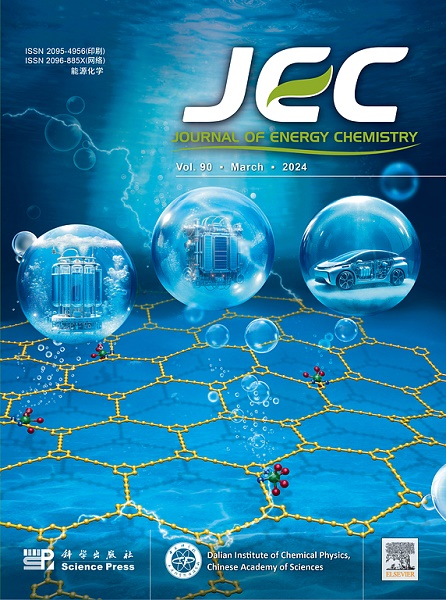Exploring damping effect of oxygen vacancies for lithium-rich layered cathode cycling at high rate
IF 13.1
1区 化学
Q1 Energy
引用次数: 0
Abstract
Lithium-rich manganese-based oxide (LRMO) cathode has emerged as a particularly promising candidate for achieving high energy densities in lithium-ion batteries due to its capability to access anion redox reactions at high voltage. The successful implementation of LRMO in energy storage systems is contingent upon the enhancement of their rate capabilities. However, the underlying relationship between high-rate cycling and electrode degradation for LRMO, particularly concerning structural evolution, still remains unclear. Benefiting from the high time resolution abilities of liquid-metal-jet operando two-dimensional X-ray diffraction, it is observed that the Li2MnO3 phase in LRMO is gradually activated accompanied by the emergence of oxygen vacancies during cycling at 1 C (1 C = 250 mA/g). Consequently, the crystal lattice flexibility of LRMO is systematically enhanced, thereby preventing the collapse of the bulk structure. While, continuous release of oxygen during extended cycling results in deteriorations of the self-adjusting damping effect of the structure, ultimately leading to a decline in capacity. The findings of this study not only contribute to a more profound understanding of the structural changes of LRMOs at high rates, but also provide novel perspectives for the rational design of LRMOs with superior rate performances.

探讨氧空位对富锂层状阴极高速循环的阻尼效应
富锂锰基氧化物(LRMO)阴极由于能够在高压下进行阴离子氧化还原反应,已成为锂离子电池中实现高能量密度的特别有前途的候选者。LRMO在储能系统中的成功实施取决于其速率能力的提高。然而,高速率循环与LRMO电极降解之间的潜在关系,特别是结构演变,仍然不清楚。利用二维x射线衍射的高时间分辨能力,观察到在1℃(1℃= 250 mA/g)循环过程中,LRMO中的Li2MnO3相随着氧空位的出现逐渐被激活。因此,系统地增强了LRMO的晶格柔韧性,从而防止了体结构的崩溃。而在长时间循环过程中不断释放氧气,导致结构的自调节阻尼作用恶化,最终导致容量下降。本研究的结果不仅有助于更深入地了解高速率下LRMOs的结构变化,而且为合理设计具有优异速率性能的LRMOs提供了新的视角。
本文章由计算机程序翻译,如有差异,请以英文原文为准。
求助全文
约1分钟内获得全文
求助全文
来源期刊

Journal of Energy Chemistry
CHEMISTRY, APPLIED-CHEMISTRY, PHYSICAL
CiteScore
19.10
自引率
8.40%
发文量
3631
审稿时长
15 days
期刊介绍:
The Journal of Energy Chemistry, the official publication of Science Press and the Dalian Institute of Chemical Physics, Chinese Academy of Sciences, serves as a platform for reporting creative research and innovative applications in energy chemistry. It mainly reports on creative researches and innovative applications of chemical conversions of fossil energy, carbon dioxide, electrochemical energy and hydrogen energy, as well as the conversions of biomass and solar energy related with chemical issues to promote academic exchanges in the field of energy chemistry and to accelerate the exploration, research and development of energy science and technologies.
This journal focuses on original research papers covering various topics within energy chemistry worldwide, including:
Optimized utilization of fossil energy
Hydrogen energy
Conversion and storage of electrochemical energy
Capture, storage, and chemical conversion of carbon dioxide
Materials and nanotechnologies for energy conversion and storage
Chemistry in biomass conversion
Chemistry in the utilization of solar energy
 求助内容:
求助内容: 应助结果提醒方式:
应助结果提醒方式:


